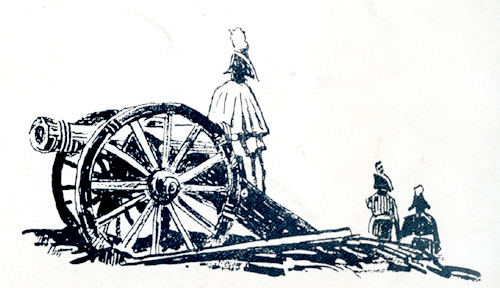"War and Peace" Souvenir Program |
Read more at in70mm.com The 70mm Newsletter |
| Written by: Harold Stern, The Walter Reade Organization, USA 1967. Prepared for in70mm.com by Anders M Olsson, Lund, Sweden from an original souvenir program provided by Johan Wolthuis, Holland | Date: 23.02.2014 |
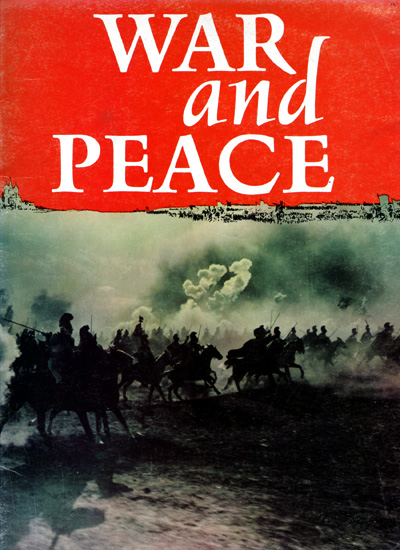 WAR AND PEACE follows the fortunes and
intricate relationships of four aristocratic families in Russia during the
eight turbulent years, 1805-1812 when the vast country was caught up in the
swirling and irresistible tides of history. The families are the ROSTOVS
(central figure: Natasha), the BOLKONSKYS (central figure: Andrei), the
KURAGINS (central figures: Helene and Anatole), and the BEZUKHOVS (central
figure: Pierre). WAR AND PEACE follows the fortunes and
intricate relationships of four aristocratic families in Russia during the
eight turbulent years, 1805-1812 when the vast country was caught up in the
swirling and irresistible tides of history. The families are the ROSTOVS
(central figure: Natasha), the BOLKONSKYS (central figure: Andrei), the
KURAGINS (central figures: Helene and Anatole), and the BEZUKHOVS (central
figure: Pierre).The story begins in 1805 when the spectre of Napoleon hung over the tapestry of Eastern Europe like a shroud. St. Petersburg is far from the scene of Napoleon's early conquests, but there is no doubt that Russia is being drawn, irrevocably, into a struggle for survival. Napoleon is the chief topic of conversation and patriotic fever is beginning to take hold of almost everyone. Prince Andrei Bolkonsky, discontented with life and marriage, looks forward to war. His friend, Pierre Bezuhov, however, has no wish to enter the army. He wants to continue the carefree bachelor life he has been sharing with Prince Anatole Kuragin. But Pierre is not to be spared responsibility. As a result of their escapades, Pierre, Anatole and Dolohov, a companion, are ordered out of St. Petersburg. Pierre returns to Moscow, where his father dies leaving him heir to an enormous fortune. In Moscow, Nikolai Rostov prepares to join the army, bidding farewell to his beloved Sonya and to his family, including his 13-year-old sister, Natasha, beautiful, spirited and on the threshold of life. |
More in 70mm reading: "War and Peace" Souvenir Program stills "War and Peace" in Amsterdam 9. November 2013 Seeing "War and Peace" in 70mm is so rare. It is like a very fine wine. You HAVE to appreciate it Sovscope 70 - 70mm Films in USSR Internet link: See "War and Peace" on YouTube: 2:20 "War and Peace" Part 1 1:33 "War and Peace" Part 2 1:17 "War and Peace" Part 3 1:33 "War and Peace" Part 4 6:43 "War and Peace" Wiki Sergei Bondarchuk Wiki "War and Peace" @ imdb |
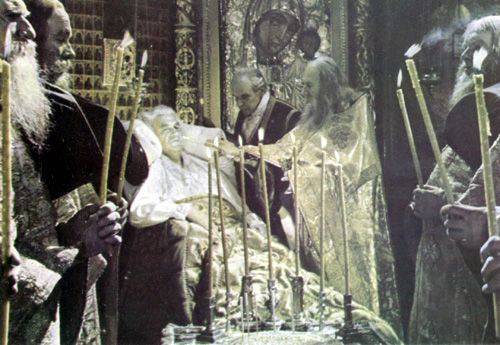 The
death of the aged Prince Bolkonsky. The
death of the aged Prince Bolkonsky.Andrei takes his pregnant wife, Liza to the Bolkonsky estate, near Moscow, before he goes off to join the army. Both Andrei and Nikolai see their first combat at the battle of Schoengraben. The next major confrontation is at Austerlitz, where the combined Russian-Austrian forces are routed by the French. Andrei is wounded and captured by the French but is reported missing in action. In St. Petersburg, Pierre is maneuvered into marriage with Helene, Anatole's beautiful but amoral sister. Shortly after the wedding, Pierre learns she has been having an affair with Dolohov. He challenges his former companion to a duel and emerges victorious after severely wounding his opponent. The marriage collapses. Pierre turns over part of his estate to Helene and leaves her. |
|
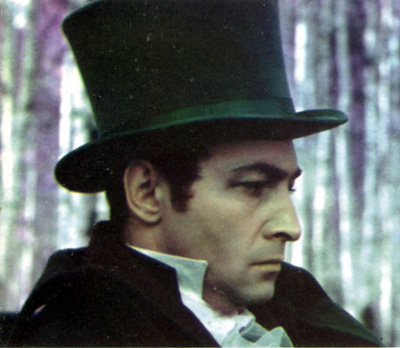 Andrei Bolkonsky. Andrei Bolkonsky.At the Bolkonsky estate, Andrei, released by Napoleon, returns unexpectedly, just as Liza is about to give birth. Liza presents him with a son and dies in childbirth. It is a morosely introspective period for Andrei and only a chance encounter with the effervescent Natasha convinces him that there is still much to live for. At almost the same time, Pierre begins to recover from the spiritual agonies of his unhappy marriage. With the war going badly, Tsar Alexander I concludes an uneasy peace treaty with Napoleon. France and Russia become allies. The years pass and in 1810, Natasha, now a young lady, attends her first ball. She and Andrei meet again and fall in love. They are soon engaged to be married, but when Andrei's elderly father, Prince Nikolai Bolkonsky, objects, the marriage is postponed for a year and Andrei goes abroad. Left alone, Natasha finds her life clouded by uncertainty. When Helene introduces her to Anatole at the theatre one evening, she succumbs to his charm and agrees to marry him. |
|
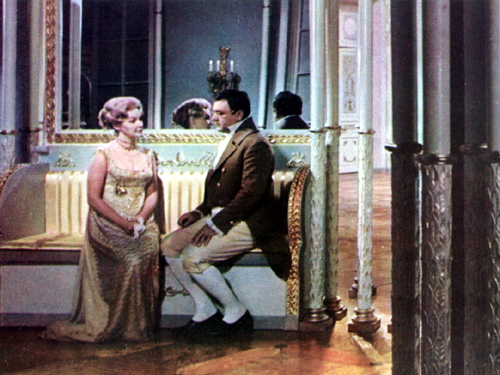 Helene
elicits a proposal from Pierre..... Helene
elicits a proposal from Pierre..... Natasha has already written to Andrei, breaking their engagement, when she discovers that Anatole is married. Pierre consoles her and for the first time reveals that he too loves her. Were he free from Helene, he would ask her to marry him. On June 12, 1812, the shaky peace collapses. Napoleon leads his armies across the Russian frontier. The Russians fall back and Kutuzov, their commander at Austerlitz, is named Commander-in-Chief of all the Russian armies. Natasha, now completely estranged from Andrei, becomes ill and despondent and Pierre decides he must join the army. He reaches the troops at Borodino where they are preparing to make their stand. The encounter is a long, bitter and pivotal one. The Russians inflict grave damage on the French before Kutuzov orders the historic retreat which leaves Moscow at the mercy of the invaders. |
|
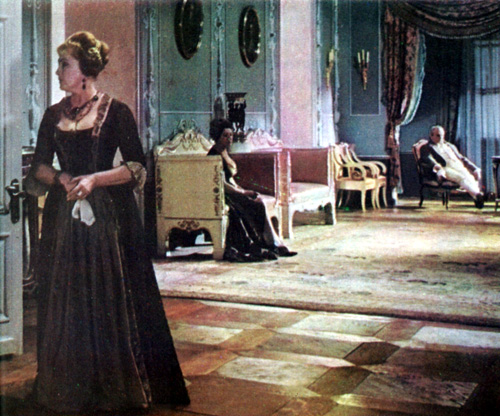 .... while her mother listens in from the next
room. .... while her mother listens in from the next
room.The battle has had a tremendous effect on Pierre. He decides that his duty to himself and to his country is to remain in Moscow to assassinate Napoleon. Andrei, who has been mortally wounded in the battle, is taken to the Rostov family, where he is reunited with Natasha. Napoleon's army reaches Moscow and finds the city all but abandoned. The French begin to loot and burn as Pierre looks for his opportunity to kill Napoleon. Before he can fulfill his mission, he is arrested as an arsonist. Despite all efforts to save him, Andrei dies of his wounds. At almost the same time, the Rostovs receive word that Helene has died. Pierre remains in jail as the undisciplined French Army continues to loot Moscow. Outside Moscow, the entire Russian populace rallies around Kutuzov and a campaign of terror and guerrilla warfare is directed against the invaders. |
|
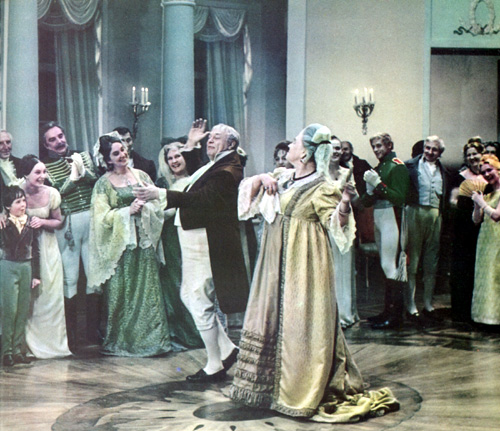 Count
and Countess Rostov dance at a party in their home. Count
and Countess Rostov dance at a party in their home.Napoleon tries to arrange peace terms and is refused, as Kutuzov continues to avoid a direct confrontation with the French. With French morale disintegrating, and without supplies and reinforcements, Napoleon is left with no alternative. He orders a withdrawal from Moscow and the "Grand Army" begins its slow and painful retreat. Encumbered by loot and prisoners, the crumbling French forces find themselves under constant sniper fire and harrassment from the partisans. A detachment of irregulars, including Dolohov, rescues the prisoners and it is only now that Pierre learns of the death of Helene as he and Dolohov settle their differences. The French retreat approaches the proportions of a rout. The Russians finally attack at Berezina and the French army is destroyed as an effective force. Only remnants escape to make the torturous trek home. There is jubilation throughout Russia and the nation begins to pick up the pieces of its epic conflict. The Rostov family returns to Moscow and Pierre and Natasha are reunited, each secure in the love of the other. |
|
Biography |
|
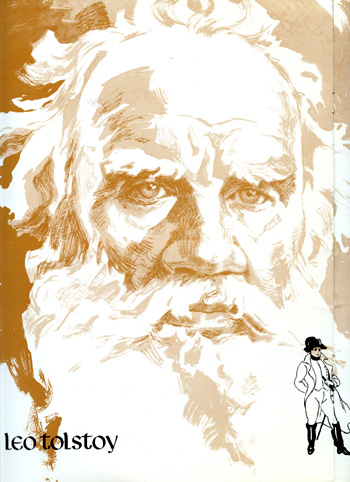 THE TOLSTOY ESTATE at Yasnaya Polyana, some
130 miles south of Moscow, is, to this day, maintained as a national Soviet
shrine and museum. THE TOLSTOY ESTATE at Yasnaya Polyana, some
130 miles south of Moscow, is, to this day, maintained as a national Soviet
shrine and museum.For it was there that Count Leo Nikolayevich Tolstoy was born on August 28, 1828. It was at Yasnaya Polyana that he wrote War and Peace, perhaps the world's greatest literary achievement and it was there, that he was brought for the last time after his death on November 7, 1910. The shrine and museum at Yasnaya Polyana symbolize the lasting importance to the world of a man who was more than simply a writer. In every sense, both Tolstoy the man and his work were larger than life. He was many things; a soldier, a pacifist, an educator, a mystic. He was licentious and devout. He was a writer of soaring imagination, yet much that was brilliant and evocative was painfully autobiographical. Perhaps his fellow Russian author, Maxim Gorky, described him best. "No man deserves more to be called a genius, no man is more complex, more contradictory, more admirable than he is in all things, yes, in all things, in some broad and indefinable way... He is a man who envelopes all men, a man... mankind." Tolstoy's own last words provide one key to understanding. At the age of 82, he began his last journey, a holy pilgrimage for contemplation of the mysteries of God and of love. He became ill, and was taken off the train at the Astopovo railroad station. He died shortly thereafter. His last words, according to his daughter, were "The truth... I love much..." |
|
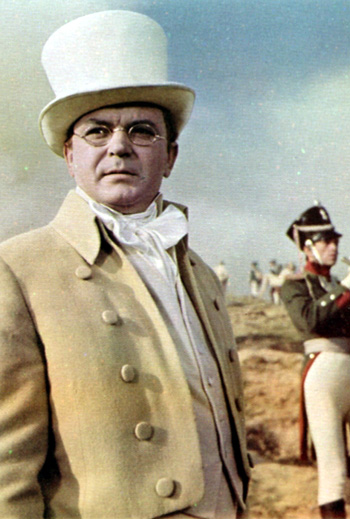 Pierre Bezuhov Pierre BezuhovLeo Tolstoy was born into a family which ranked high in Tsarist Russia's class-oriented society, the fourth of five children. His mother, Princess Maria Volkonski, died when he was two and he was raised by his two aunts. In 1836, the family moved to Moscow where, when Tolstoy was nine, his father, Nikolai, who had served in the Russian army and been captured by the French during the Napoleonic invasion, collapsed and died on the street. What had been a happy childhood, until that time, became a confused and uncertain one. In 1844, he entered the University of Kazan but showed little interest in academic knowledge and withdrew from the school before the end of his second year. He returned to Yasnaya Polyana, which he had inherited, intending to remain there. But in 1848, he returned to Moscow, where he lived the life of dissipation long associated with his class. It was during this period that the urge to write became irresistible. He was 24 when he wrote his first work, Childhood. In 1852, he entered the army and fought against the Turks at Sevastopol. He was already a well-known writer when he left the army and his career received further impetus when he was sponsored by Turgenev. But, their antagonistic philosophies soon turned these literary titans into lifelong enemies. By the time Tolstoy married Sonya Bers, 16 years his junior, in 1862, his published works included Childhood, Boyhood, Youth, The Cossacks, Sevastopol, Two Hussars and many others. His most fruitful years followed. In 1863 he began work on War and Peace. During that same year, his son Sergei, the first of 13 children, was born. When War and Peace was completed and published, it contained composite characters from among his friends and family. Many of the novel's events closely paralleled incidents from his own life. |
|
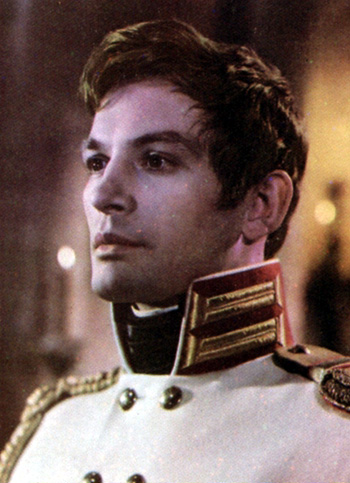 Anatole Kuragin. Anatole Kuragin.Anna Karenina followed and it was during his work on this novel that Tolstoy's spiritual struggle, his quest for the true meaning of life, first became obsessive. His spiritual awakening made his personal life seem intolerable and his religious conversion governed his actions during the last 30 years of his life. The quantity of the writing by and about him is staggering. The Russian edition of his works runs to 90 volumes, including letters, diaries and reminiscences. Tolstoy has been read and analyzed in almost every language known to man. There is little argument that his two masterpieces are War and Peace and Anna Karenina, with War and Peace occupying the place of honor in world literature. Though sales records were not maintained in Russia, it has been estimated that War and Peace has sold well over 4,000,000 copies in its many translations, elsewhere in the world, an amazing figure for a book universally regarded as a "classic." "To write a good book," Tolstoy once said, "one must love its basic, fundamental idea. In War and Peace I loved the people's emotions arising from the War of 1812... I strove to write a history of the people." Tolstoy has been described as many things. He has been called a sybarite, a saint, a tormented man, a cold and calculating social climber. He was a man of extremes, whose estimate of himself was far more critical than the appraisals of others. It seems only fitting that so complex a human being should have been the one to write a novel so complex and all-inclusive as War and Peace. |
|
The Making of "War and Peace" |
|
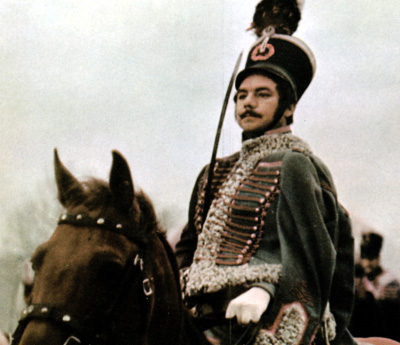 Denisov. Denisov.THE GREATEST NOVEL ever written has been turned into the greatest film ever made. Everything about this film, the first faithful screen treatment of Leo Tolstoy's epic novel, is of staggering dimension. Compared to the statistics of War and Peace, such conventional Hollywood descriptive terminology as "Gigantic," "Stupendous," and "Enormous" must be translated to mean miniscule. Never in the history of film making has there been a feature encompassing so much on so many levels. With a production cost of $100,000,000, there is no other contender for the claim of War and Peace that it is the most expensive motion picture ever made. With five years of active and concentrated production required for the completion of the film, no picture has ever demanded more time and effort. Never before has the catch phrase "cast of thousands" been as meaningful. In the staging of the battle of Borodino alone, 120,000 soldiers were employed. The enormity of the undertaking can only be hinted at with the use of statistics. |
|
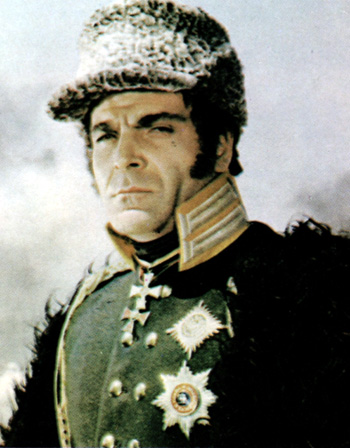 General Bagration. General Bagration.The cast includes 30 of the finest Soviet stage and screen stars. Only a single newcomer was used, Ludmila Savelyeva, who was entrusted with the vitally important role of Natasha Rostova after a talent search rivaled in motion picture history only by the search for an actress to play Scarlett O'Hara in Gone With The Wind. Set construction was not only a major production problem, it was an incredible achievement. 103 outdoor sets were constructed, depicting the streets of Moscow and St. Petersburg, the old Kremlin and a variety of battle locales. There were 69 additional outdoor sets, constructed to simulate the gardens and parks of the 19th century nobility, plus remote villages and complete battlefields. Over 100 indoor sets included one of a ballroom as large as the largest ballroom in the Winter Palace or in Leningrad's Hermitage. It has been estimated that enough sets were constructed for War and Peace to supply the complete set needs of 15 ordinary full-length feature films. Props, including paintings, art treasures, weapons and books were borrowed from over 40 Soviet museums and libraries. It took 47 different businesses and factories working full time for five years to supply the clothing and equipment used in the picture. |
|
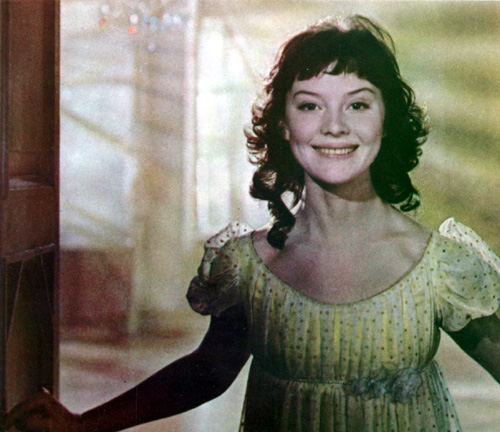 Natasha,
only 14 years old, first enters the story in "War and Peace." Natasha,
only 14 years old, first enters the story in "War and Peace."In addition to the military uniforms of many nationalities, including Russian, French, Austrian, Italian and Polish, there were over 2,000 separate and distinct civilian costumes, covering all strata of Russian society from Tsar to peasant. The armed forces used 160 artillery pieces, 120 wagons, 7,000 swords and daggers, 52 tons of smoke compound, 23 tons of gunpowder, 16,600 hand grenades, 6,600 white smoke bombs and 4,500 fuses. The flame and smoke effects for the three major battle sequences consumed over 105,000 tons of kerosene. The battle of Borodino was probably the single most important and the largest scene ever created for films. A complicated scene, perhaps ever more vital to the success of the film than to the success of the original novel, it was made even more difficult by director Sergei Bondarchuk's insistence on absolute, detailed authenticity. The soldiers impersonating French troops were drilled to march at the rate of 120 steps per minute, as required by French military regulations at the time of the action. The Russian troops were trained to march at 75 steps per minute. |
|
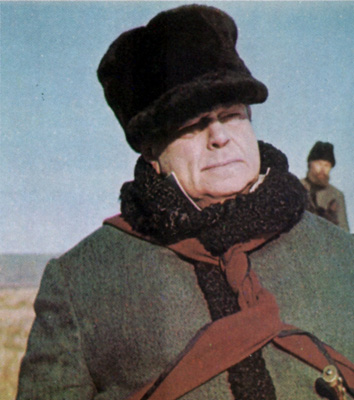 Count
Rostov. Count
Rostov.Bondarchuk's stress on authenticity shows up throughout the picture. With the military action covering the period 1805-1812, the slight changes which took place in the military uniforms were duly duplicated. Every telephone and telegraph pole within miles of the site of the staged battle of Borodino was removed just prior to the anticipated filming of the scene. All were replaced when the weather failed to provide the expected snowfall and the film went off to shoot elsewhere. All the poles were removed once again when the work could be undertaken and were replaced a second time at the conclusion of the filming. Nothing was left to chance. Care was exercised in the battle scenes to follow the original battle plans and to station the troops in the exact positions where they fought originally. The re-creations of the battle scenes were done with such intensity that the luckiest performers were the ones playing the first to fall. As the battle continued to rage about them, they seized upon this opportunity to rest. No detail was too small to come under the scrutiny of Bondarchuk and his crew. On at least one occasion, the services of agricultural specialists were utilized. |
|
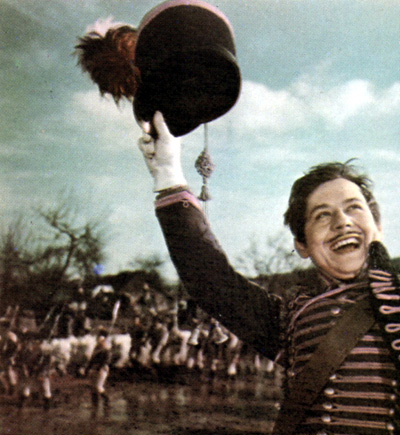 Nikolai
Rostov. Nikolai
Rostov.For one battle scene, to conform to Tolstoy's exact description, a field in front of a line of fortifications had to be changed from a bean field into a wheat field. 158 scenes were shot on the four sound stages of the Mosfilm Studios. 168 different, actual and re-created locations were also used. In discussing the task of turning the novel into a film, director Bondarchuk remarked that several approaches had been considered. "Our desire was always to convey what Tolstoy wanted to say with the utmost fullness and consistency," he said. "We have tried to involve the spectator in the events on the screen, to make him experience what Tolstoy's characters experienced and the atmosphere in which they lived. |
|
Russian Cinema |
|
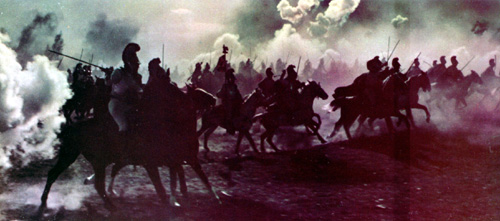 LENIN declared in 1919, "Of all the arts, the
cinema is the most important to us." Thus began a unique chapter in the
history of the motion picture art, a chapter to which new and constantly
more exciting pages are still being added. LENIN declared in 1919, "Of all the arts, the
cinema is the most important to us." Thus began a unique chapter in the
history of the motion picture art, a chapter to which new and constantly
more exciting pages are still being added.The Soviet leader's observation established an entirely new basis for motion pictures; government sponsorship of the production of films which would serve a political as well as an entertainment purpose. If the first films to emerge from this government supervision were little more than newsreels, the art of the cinema in Russia grew and matured. Amidst a majority of films simply serving the aims of the government, appeared a brilliant minority of truly experimental cinema classics made by men like Kuleshov, Pudovkin and the great Eisenstein who introduced startling new techniques to the screen that significantly influenced the work of filmmakers all over the world. |
|
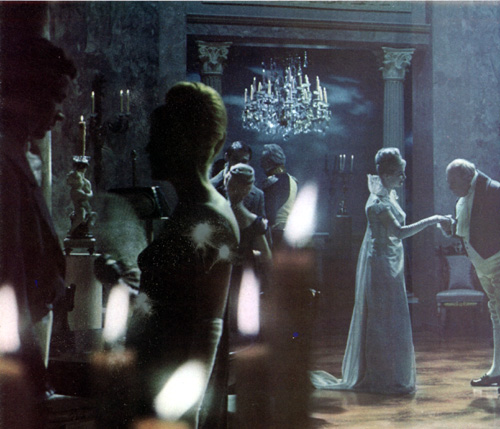 Russian
nobility gather at a Moscow salon. Russian
nobility gather at a Moscow salon.When Josef Stalin took over the leadership of the Soviet Union and solidified his control, the production of these more rarefied works of the cinema ceased and the first "Golden Age" of the Soviet cinema was over. This hiatus continued with Stalin. As recently as the early 1950's, the average output of the Russian film industry was only 15 feature films, most of these oriented toward the educational policies of the Stalin government. Conditions eased considerably with the death of Stalin in 1953. Though by Western standards the Soviet film industry is still highly regimented, by previous Soviet standards it has become liberal to a degree that is attracting many exciting new talents to film production. The extent to which the film industry in the U.S.S.R. has grown in little more than a decade may best be revealed statistically. Production has increased from an average of 15 features annually to more than 125 per year. There are now 42 studios in the U.S.S.R. which produce feature motion pictures, including at least one in each of the 15 Soviet republics. There are approximately 7,000 35mm theatres in the Soviet Union. In addition, there are more than 115,000 16mm theatres in factories and on state and collective farms and there are some 20,000 mobile units which service areas that have no facilities. |
|
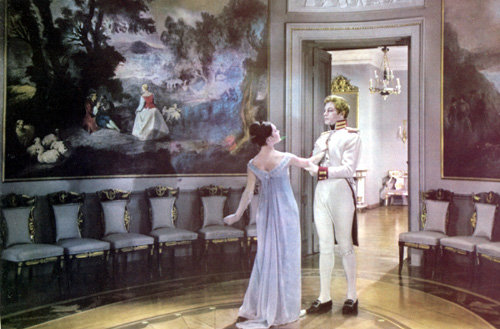 Natasha
and Anatole meet secretly and agree to elope. Natasha
and Anatole meet secretly and agree to elope.Annual attendance in the Soviet Union averages between four and four-and-a-half billion, more than twice the number of tickets sold in the United States each year. A typical Russian attends feature films about 20 times a year; a typical American attends about 6.5 times. About 75 motion pictures are imported annually, most of these from Soviet bloc countries but an increasing number recently from the United States. Almost any foreign film shown in the Soviet Union will attract sizeable audiences. Ticket prices in the U.S.S.R. are low, often as low as one tenth of tickets in the United States. A lot of moviegoing is guesswork, however, since Russian motion picture studios don't indulge in press agentry and most newspapers don't carry motion picture advertising. The Soviet film industry today is in a promising state of change. In recent years, films produced in Russia have scored both critical and financial successes in the West; The Cranes Are Flying, Ballad of a Soldier, Hamlet, and A Summer to Remember are but a few of the more popular. In the entire history of the Soviet film industry, however, no film and no filmmaker have received the attention, the financial backing, and the artistic freedom that was given to War and Peace and its director, Sergei Bondarchuk. It's as if this one film was to be the international representative of the new Soviet cinema; the film cost $100,000,000 to make; production took five years; every required facility, talent and resource of all the arts in the U.S.S.R. was made available to Bondarchuk. The result is a motion picture that has earned world wide praise, both from the critics who demand art and the audiences who demand entertainment. War and Peace certainly signals a second "Golden Age" for cinema in the Soviet Union. |
|
The Walter Reade Organization |
|
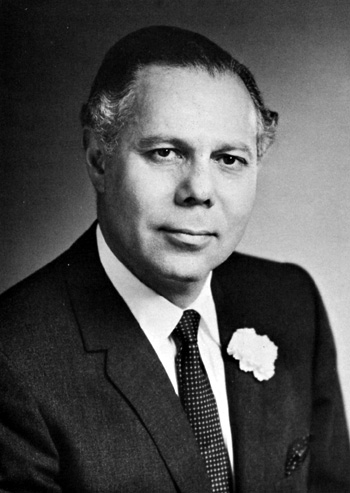 Walter
Reade, Jr., President and Chairman of the Board Walter
Reade, Jr., President and Chairman of the BoardTHE WALTER READE ORGANIZATION, under the dynamic leadership of Walter Reade, Jr., President and Chairman of the Board, is one of the fastest growing companies in the entertainment field. A fully integrated entertainment complex which owns and operates motion picture theatres, produces and distributes motion pictures, and is a vital force in the television, 16mm and educational film fields, the Reade Organization takes great pride in its record for innovation in entertainment. War and Peace, the first Russian motion picture to be released in the United States on a major nationwide basis, the first motion picture to be released in two parts, and the most expensive motion picture ever made, certainly fits into this category. Mr. Reade began his negotiations for the rights to the film several years ago when the project was still in the drawing board stage in Moscow. He made several trips to the Soviet capitol before and during the five year production period of War and Peace and, in partnership with the Satra Corporation, eventually convinced the Russian film industry that his organization was best suited to give the film the unique handling required. The history of the Reade Organization gives clear evidence of this special knack for the imaginative. Most recently, there was the highly acclaimed film version of James Joyce's Ulysses, produced and distributed by the Reade Organization through Continental, its motion picture division. Mr. Reade served as executive producer on this project which was thought of as one of the "impossible" books for motion pictures until rave critical reviews and an equally enthusiastic audience response made Ulysses the surprise success of 1967. Over the years, such films as David and Lisa, Lord of the Flies, Room at the Top, The Gospel According to St. Matthew, Saturday Night and Sunday Morning, Loneliness of the Long Distance Runner, and The Organizer have given Continental its reputation for quality, creativity, and imagination. Today, what began as a small New Jersey theatre operation has grown into a multi-million dollar organization. There are now 61 theatres stretching from Los Angeles to Boston, from New Orleans to Chicago, under the Reade banner, including seven quality first run theatres in Manhattan. Similar growth has been evidenced in all divisions of the Reade Organization over the years. Now, with War and Peace, certainly the most ambitious, the most expensive and, according to many critics around the world, the finest motion picture of all time, the Reade Organization takes another giant step forward. |
|
People |
|
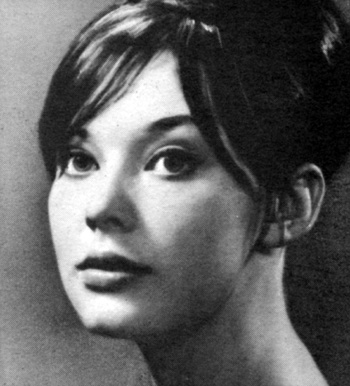 LUDMILA SAVELYEVA as Natasha Rostova. LUDMILA SAVELYEVA as Natasha Rostova.Ludmila Savelyeva is the heroine of a Russian Cinderella story. The lovely young lady, who plays the vital role of Natasha Rostova in War and Peace is making her first appearance as an actress in her country's most important motion picture. She is beginning her acting career as a star, not only as a star within the confines of the Soviet Union, but as a major international star, a position attained by very few Soviet performers. The importance of her role and the quality of her performance, coupled with the fact that War and Peace will probably be seen and talked about by more people than any other Russian film in history, insure her world-wide stature. In addition, Miss Savelyeva has made personal appearances outside of Russia and was better known before anyone saw War and Peace than most Soviet stars who've been working for a lifetime. She was born in Leningrad during the World War II siege in 1942 and the first sounds she heard were those of bombs and anti-aircraft guns. Her first interest in the arts was ballet and she trained at the Leningrad Choreographic School and later danced in The Sleeping Beauty, Giselle and Swan Lake. As far as she was concerned, her future was in ballet. Chance sent her to the Mosfilm Studios where she was offered a role in a film called Drawing the Bridge. While she was there, she was noticed by director Sergei Bondarchuk. Something about her intrigued him and he asked her to test for the role of Natasha, a character she had known and loved since childhood. She was asked to do five takes of one of the film's most difficult scenes, and each was better than the preceding one. She was hired for the role. A spokesman for the studio recently told a press conference that prior to finding Miss Savelyeva, 3000 applicants had been seen and tested for the role. With one possible exception, no one has ever regretted her selection for the role. Before testing for the part, Ludmila was engaged to be married. The then 19-year-old had to agree not to marry as long as she was involved with the production of the film, a matter, as it turned out, of some five years. She has since married. |
|
 SERGEI BONDARCHUK as Pierre Bezuhov. (Also director of War and Peace and
co-author of the screenplay). SERGEI BONDARCHUK as Pierre Bezuhov. (Also director of War and Peace and
co-author of the screenplay).Sergei Bondarchuk is one of the few members of the Soviet film profession who is known not only in his own country but on an international scale as well. Almost everything he has done, as a producer, director, writer or actor, has received wide popular and critical acclaim. In many ways, he is the Russian counterpart of Orson Welles. War and Peace is Bondarchuk's personal project. He served as both producer and director, he co-authored the screenplay and he portrays Pierre Bezuhov, the single character who, more than any other, is Leo Tolstoy's philosophical spokesman. Bondarchuk was born in 1922. He studied for the theatre at the Rostov School of the Gorki Theatre, where he quickly distinguished himself as an actor. In 1948, he was graduated from the Soviet State Institute of Cinematography and he has been concerned exclusively with the cinema ever since. Some of his chief films as an actor were The Young Guard, The Cavalier of the Golden Star, Unfinished Story, Soldiers Were Marching, The Grasshopper, Othello, Era Notte A Roma, Ivan Franko and Destiny of a Man. This latter film was also his first directorial stint and earned him the Lenin Prize in the Soviet Union and many honors abroad. Prior to that, he had won recognition as an actor for his portrayal of the title role in Taras Shevchenko. Five years of his life were devoted to the production of War and Peace, possibly the greatest epic film produced anywhere in the world. |
|
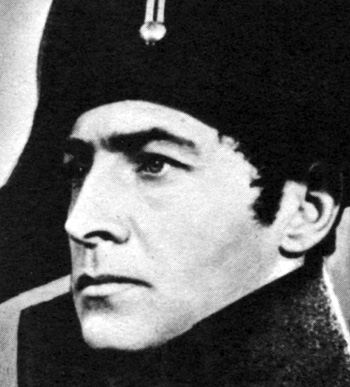 VYACHESLAV TIHONOV as Andrei Bolkonsky. VYACHESLAV TIHONOV as Andrei Bolkonsky.Vyacheslav Tihonov's burning ambition from the time he saw his first film was to become a screen star. When he was 17, he left his home in a small industrial town where he worked as a lathe hand, to come to Moscow to become an actor. It took him a while to overcome his fear and to apply for admission to the Institute of Cinematography's acting department. Despite the competition, he was accepted and, while still a freshman, earned a role in his first film, The Young Guard. After graduation, he was able to continue acting in films but, to his dismay, he was cast in a succession of similar, superficial roles. Eventually, he came to be regarded as a one-dimensional juvenile actor. He pinpoints 1957 as the year in which his fortune took a turn for the better. A former acting classmate, now a director, offered Tihonov his first opportunity to portray a multifaceted screen character. Delighted at this chance to break out of his pigeonhole, Tihonov spent several months researching his role by living in a village much like the one his screen character lived in. He won recognition for his skillful portrayal and moved on to a better and more difficult role. He next impressed everyone with his work in the Soviet-Czechoslovak co-production, May Stars. Complex roles in The Midshipman Panin, Two Lives and An Optimistic Tragedy followed. Today, no one thinks of Tihonov as one of those vapid juvenile heroes. Instead, he is one of the actors first thought of by directors when they want someone capable of handling an in depth, psychological role. And each new role offers his fans a new insight into his talents. The role of Andrei in War and Peace is another skillful and revealing performance. |
|
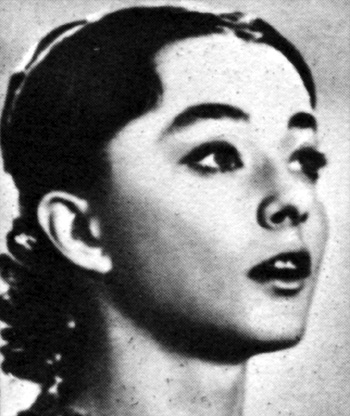 ANASTASIA VERTINSKAYA as Princess Liza. ANASTASIA VERTINSKAYA as Princess Liza.Anastasia Vertinskaya recently remarked that of all her screen roles, the part of Princess Liza in War and Peace gave her her greatest satisfaction. "It was my first taste of the artistic freedom a director allows an actor," she said. "As I worked on the role, I learned how to improvise and felt new qualities within myself that I had never been previously aware of." She is the daughter of noted Soviet poet, composer and actor, Alexander Vertinsky, and painter and actress Lydia Vertinskaya. Her sister Marianna is also an actress. She is a student at the Shckukin Theatre School in Moscow and she is married to actor Nikita Mikhalkov. Her first film appearance was in Crimson Sails. She has since appeared in The Amphibian Man, Hamlet and Anna Karenina, in addition to War and Peace. |
|
 VICTOR STANITSIN as Count Rostov. VICTOR STANITSIN as Count Rostov.Victor Stanitsin is a noted stage director, responsible for widely acclaimed productions of The Pickwick Club (from Dicken's The Pickwick Papers), The Last Days of Pushkin, An Ideal Husband and Maria Stuart, all of which are now regarded as classics of the Russian theatre. He has both directed and acted with the Moscow Art Theatre. Many of the characters he has portrayed as an actor fall under the general heading of grotesque and it is a challenge to Stanitsin's talents to find some individual characteristic for each of them on which he is able to focus, so as to make each portrayal completely unique and thoroughly believable. The character he portrays, Count Ilya Rostov in War and Peace is said to have been patterned after Tolstoy's grandfather, Count Ilya A. Tolstoy. |
|
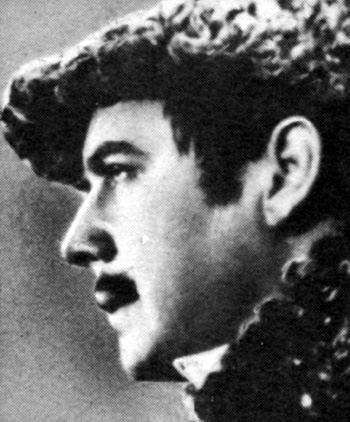 OLEG TABAKOV as Nikolai Rostov. OLEG TABAKOV as Nikolai Rostov.A young actor, Oleg Tabakov is perhaps best known to Russian audiences for his more than twenty appearances with the Central Children's Theatre and the Contemporary Theatre. He has appeared in many contemporary Russian films, often cast in the role of a modern youth, desperately groping to find a purpose and a way in life. A versatile actor, he will leap at the chance to play any character that is different than his own personality. Prior to War and Peace, he excelled as the Lieutenant in the film The Quick and the Dead. |
|
 ANATOLY KTOROV as Prince Nikolai Bolkonsky. ANATOLY KTOROV as Prince Nikolai Bolkonsky.A member of the Moscow Art Theatre acting company, Anatoly Ktorov has made many appearances on both stage and screen. On film he has been seen in The Feast of St. Jorgen, A Suit for Three Million and others. In the theatre, he has distinguished himself in A Charming Liar, The Pickwick Club and The Last Victim, to cite a few. |
|
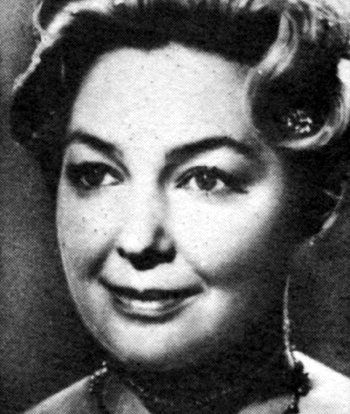 IRINA SKOBTSEVA as Helene. IRINA SKOBTSEVA as Helene.Irina Skobtseva had her heart set on a stage career, but film offers kept getting in the way. She was graduated from the art research department of Moscow University, then entered the Moscow Art Theatre School. In the ten years since her graduation from the latter, she has become an established screen star. One of her first film roles was as Desdemona in Othello, which was enough to call everyone's attention to the fact that she was an actress of great emotional depth and power, and a beautiful woman as well. Other of her films include An Ordinary Person, An Unusual Spring, The Duel (in which she portrayed a character somewhat akin to the role of Helene she plays in War and Peace), Annushka, Towards the Sunrise, Seryozha, Madmen's Trial and I Walk Around Moscow. She is the wife of Sergei Bondarchuk, producer, director and co-star of War and Peace. |
|
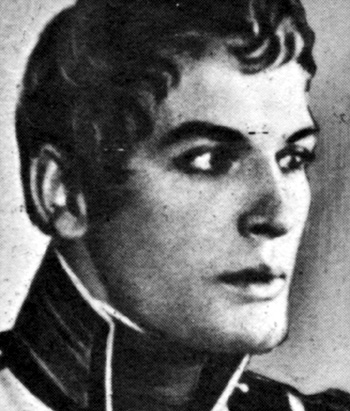 VASILY LANOVOI as Anatole. VASILY LANOVOI as Anatole.The fact that Vasily Lanovoi is possibly the handsomest of all Soviet film actors interfered with the progress of his screen career for many years. His features typecast him instantly and directors seemed not at all concerned with his acting ability. His early screen roles showed little but good looks. Where he was fortunate was that he was a member of Russia's famous Vakhtangov Theatre company and was able to portray a wide variety of roles in productions ranging from Princess Turandot to Bernard Shaw's The Millionairess. He began to make his mark in films with roles in Colleagues and Into The Storm, but it is his work in War and Peace which firmly establishes him as a mature and deeply understanding screen actor. His next two films will be No Password Needed and Anna Karenina. |
|
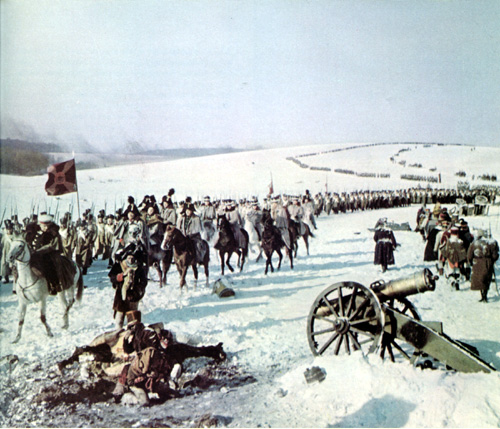 Napoleon's
troops retreat from Moscow. Napoleon's
troops retreat from Moscow.STEPANOVA as Anna Scherer. Angelina Stepanova became a member of the Moscow Art Theatre company immediately after graduation from the Evgenie Vakhtangov Studio, arriving just in time to appear in the much celebrated production of Princess Turandot. She has now been with the Moscow Art Theatre for over 40 years, and has worked for most of the outstanding directors of the Soviet Union, including Vakhtangov and Stanislavski. She has had the opportunity to appear in virtually every play which is a part of the company's enormous repertoire. A few of them include The Three Sisters, The Cherry Orchard, Maria Stuart, Resurrection, An Ideal Husband and Anna Karenina. She has played Dostoyevsky, Schiller, Wilde, Chekov and Tolstoy. Anna Scherer, whom she portrays in War and Peace, is the hostess of the St. Petersburg soiree which introduces many of the film's leading characters. |
|
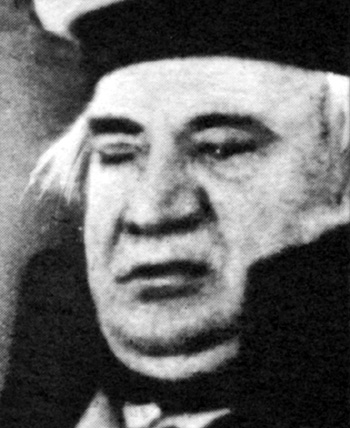 BORIS ZAHAVA as Kutuzov. BORIS ZAHAVA as Kutuzov.Professor Boris Zahava is an actor, a teacher and the recognized heir to the tradition of the noted Russian stage director, Vakhtangov, whom he met in 1923 while a student at the Institute of Commerce. Zahava was the leading actor in the first plays staged by Vakhtangov, while the latter was still an unknown. Later, he became Vakhtangov's co-director of Princess Turandot, in which he also played Khan Timur. In addition to his work in the Vakhtangov Theatre Zahava also performed in the Meyerhold Theatre in the 1920's. He first won recognition as a director for his staging of Gorky's Yegor Bulichev and Others, in which he also appeared, earning the Vakhtangov company the personal praise of Gorky. Zahava has been directing the Pushkin School for over 40 years and has taught in many of the Soviet Union's theatre workshops as well as at the State Institute of Cinematography. He feels his work with Sergei Eisenstein on The Bezhin Medal helped qualify him for his role as Kutuzov in War and Peace, the character who has been called the only true individual hero of the epic. |
|
 VLADISLAV STRZHELCHIK as Napoleon. VLADISLAV STRZHELCHIK as Napoleon.One of the busiest of all Russian actors, Vladislav Strzhelchik has appeared in 18 films during the past seven years. He had completed his role as Napoleon in War and Peace, long before his previous important picture, The Blue Bracelet, had been released and is currently doing How Should We Call You Now and The Destruction of a Squadron. He works so fast, he had to be discovered twice, once for the screen by Georgi Vasiliev, who directed him in October Days, and once for the theatre by Georgi Tovstonogov. He has portrayed a vast range of characters, including Dostoyevski's The Idiot, Ruy Blas, the cynic in Gorky's The Barbers, Shakespeare's Romeo and many others. |
|
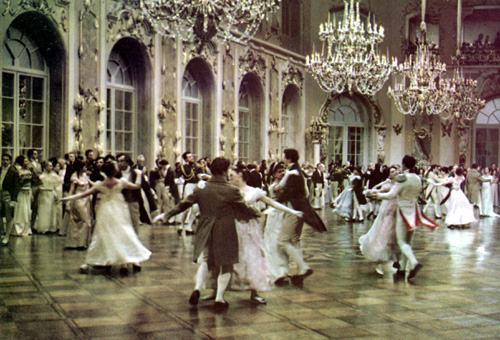 Russian
nobility dances at the Tsar's ball. Russian
nobility dances at the Tsar's ball.VYACHESLAV OVCHINNIKOV the Composer. Vyacheslav Ovchinnikov reached his 30th birthday at about the same time he completed his work on War and Peace. Long involved with the cinema, he wrote his first two film scores as a first-year student at the Moscow State Conservatory. He followed these with music which won the Grand Prix at the Venice International Film Festival. Another score won international recognition at the Cannes Film Festival. His work impressed Sergei Bondarchuk and the director asked him to write the music for War and Peace. Ovchinnikov accepted happily and spent the next five years working on the epic film. He bolstered his original score by judiciously drawing on both classical and folk music sources. He readily admits that his work on War and Peace was helped by the fact that he was working on the score for A Long and Happy Life, a contemporary film, at the same time. Going back and forth between two musical styles stimulated him creatively. At the moment, Ovchinnikov is seriously considering giving up his film work to concentrate on other types of composition. He is now working on a song cycle to the poems of Ivan Bunin and confesses that, though he believes the form has just about outlived its time, he would like to write an opera. |
|
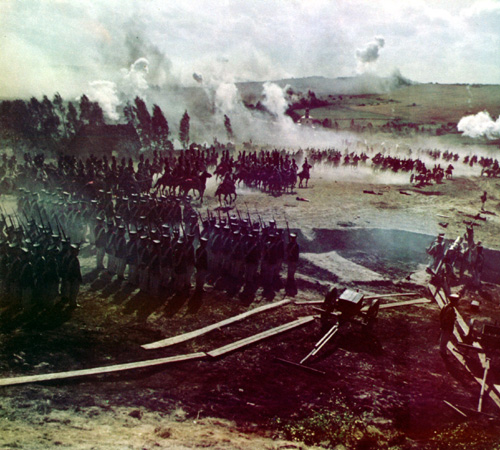 The
French cavalry charges during the Battle of Austerlitz. The
French cavalry charges during the Battle of Austerlitz.VLADIMIR BURMEISTER the Choreographer. For Vladimir Burmeister, famous in the Soviet Union as the producer of such ballets as The Snow-Maiden, Joan of Arc and Swan Lake, War and Peace marks the first time he has ever worked in motion pictures. His task was to bring to life the dances described by Tolstoy in the novel. "The dances are designed to give a deeper insight into the characters in the film and to convey to the audience some idea of Russian aristocratic circles at the beginning of the 19th century," he told an interviewer. "I came to my job with no knowledge of the principles governing the staging of dances for the camera," Burmeister said, "and I found it extremely difficult." The choreographer worked very closely with director Sergei Bondarchuk in plotting the dance in conjunction with the action. "We depended on our intuition and on improvisation," he said, "keeping within the limits provided by Tolstoy." One of Burmeister's major problems, which he quickly solved, was the number of dancers he had to work with. Prior to War and Peace, the greatest number he had choreographed for anything was 300. In the scene referred to as "Natasha's First Ball," he was forced to cope with over 800. |
|
|
|
|
Character Actors |
|
|
Natasha Rostov LUDMILA SAVELYEVA |
|
Mosfilm Production Staff |
|
|
|
|
Credits |
|
|
COPYRIGHT © WALTER READE ORGANIZATION, 1968. |
|
English Language Version |
|
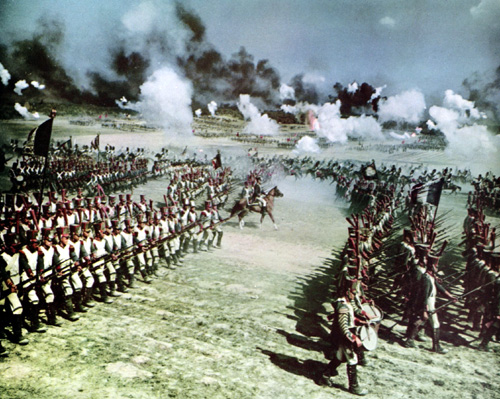 Russian
troops assemble at the Battle of Borodino. Russian
troops assemble at the Battle of Borodino.SIDNEY KATZ, A.C.E., Supervisory Editor. Sidney Katz was given the immense responsibility of converting the Russian version of War and Peace into the two part English language version to be released in this country. In addition to the immediate problems of eliminating extra sets of titles, placing the two intermissions and combining the four films the Russians made into one two-part entity, Katz, through highly selective editing, accelerated the pace of the film closer to that of American films. He began his career as a film editor at RKO-Radio Pictures in 1935 and, has been constantly active in both motion pictures and television ever since. He was film editor for the entire Defenders TV series, winning an Emmy for his efforts and among his other credits are Ed Murrow's See It Now TV series, the Doctors and Nurses TV series, and the motion pictures, End as A Man and A Lovely Way to Die. |
|
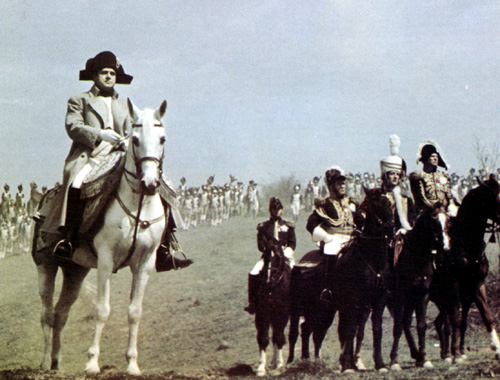 Napoleon
observes the Battle of Borodino. Napoleon
observes the Battle of Borodino.LEE KRESSEL, dialogue adaptation and direction. The demanding task of creating an English language version of the Russian War and Peace fell to the foremost specialist in the field, Lee Kressel. As a combination dubbing director, translator, casting director and English language dialogue adapter, Kressel has earned his lofty reputation for his work on the English language versions of such films as Shop on Main Street, Divorce Italian Style and The Birds, the Bees and the Italians, to name but a few. He began his theatrical career as a stage actor, entered motion pictures as a dialogue director coaching Italian actors for English roles and eventually wound up in his specialty. He now works on an average of 12 films a year, translating them into English from any of the ten different foreign languages with which he works. |
|
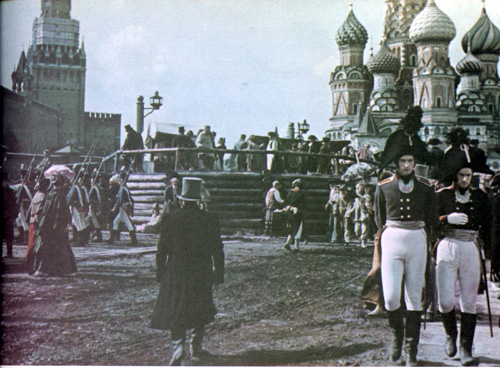 Moscow returns to normal after Napoleon's retreat. Moscow returns to normal after Napoleon's retreat.Dialogue Adaptation and Direction by: LEE KRESSEL for TITAN PRODUCTIONS Supervising Editor: SIDNEY KATZ, A.C.E. Sound Mix: FINE RECORDING, INC. Title and Introduction Created by: ELINOR BUNIN Color by: MOVIELAB, INC. Narration Written by: ANDREW WITWER Narrator: NORMAN ROSE Project Co-ordinator: ANDREW L. SAGER Technical Liaison: ALEX GOITEIN Text by HAROLD STERN Designed and Directed by KARL LEABO Published by NATIONAL PUBLISHERS, INC Additional copies of this program can be obtained by mailing $1.00 plus 25¢ for postage to National Publishers, Inc., 1472 Broadway, New York, N.Y. 10036 |
|
| Go: back - top - back issues - news index Updated 21-01-24 |


